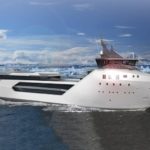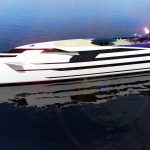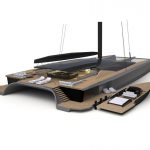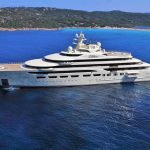Nobody in the industry really has a clue how the market will be a year from now, especially with Brexit thrown into the equation, however it has apparently matured and slowed. Buying a superyacht is no longer done on a whim, with a profit guaranteed, as it was pre 2008, writes Nick Jeffery
The Superyacht market is »unpredictable. Like last year. And next year. The segment that seems to be squeezed in particular[ds_preview] is around 60-70m, with more obvious activity above and below that benchmark«, states designer Dickie Bannenberg of Bannenberg + Rowell, adding, »Americans were more active, even pre-Brexit, so let’s see if even greater currency firepower makes a difference.« Nick Edmiston, Chairman of superyacht brokerage firm Edmiston, says, »There are buyers out there but people are being selective and realistic.« Vripack Yachting, Dutch naval architects, state: »Overall we would say the market is still not good. This remains very interesting as we strongly believe that there is no serious competition to the experience one can have on a yacht, about any size, sail or motor. One could question: is the industry supplying the right products to the market?«
Mediterranean Yacht Brokers Association (MYBA) President, Fiona Maureso, told HANSA in early July that the charter market was noticeably down on 2015 however MYBA members were expecting (hoping for) a last-minute boom during the peak season itself. Maureso, heading Northrop & Johnson’s charter operations in France, noted that the Russian charter market is significantly down. One Monaco-based broker, whose clientele is almost exclusively Russian, confided to being 90% down on 2015 bookings, however that could of course be in part due to other brokerage firms eating into their market share as Russian charterers are fickle and shop around. Wealthy Russians, if not chartering, are certainly moving to obtain residency for their families in Monaco (causing rents to rocket), enjoying functions at the Yacht Club de Monaco.
Superyacht decadence of the noughties has been replaced with a rather more low-key, less ostentatious style and »post Panama Papers« owners realise they cannot hide ownership so easily today. Sir Philip Green, taking delivery of a larger replacement superyacht just as he is being criticised for and questioned about his business ethics, is a warning of how flamboyant superyacht lifestyles can be used against one. Discretion and low-key is a trend. Witness the 34m Mulder-built »Solis« (see HANSA 9/2015), a modest family superyacht for a family who could comfortably afford much bigger. Designed by Claydon Reeves, who are touting around the explorer yacht »Cosmos« while they do a 36m Mulder, she won a World Superyacht Award in May. Explorer type yachts, with understated interiors, which can offer voyages off the beaten track are certainly increasing their market share. »Yersin« launched in summer 2015 is a fine example, specially thanks to its commitment to the Prince Albert II Foundation and her owner, François Fiat, plans to do research from the Arctic to Antarctic. She featured in the Cannes Film Festival edition of The Hollywood Reporter under the banner »Superyachting, sans the guilt«.
Hawk Yachts, established by the German joint captains of »Lady Moura« recently increased its presence in Antibes with a marketing arrangement with De Valk brokerage. The experienced team presented a range of serious explorers at Monaco Yacht Show 2015, with National Geographic showing interest. Lifestyle experiences is what the new younger entrepreneur is looking for and chartering these kind of vessels could be a growth niche. »Legend« was relaunched this summer, after a total refit at Icon Yachts, and is cruising Norway’s fjords. Owner operator Jan Verkerk knows the market well, his other vessel »Sherakhan« already having proved successful. Tony Dixon, Director at Redman Whiteley Dixon, with four Feadships in build, confirms this trend: »I’ve noticed a few explorer-style yacht companies advertising and numerous concept proposals – this is a vessel style for which there are not so many afloat and I believe appeals to the younger, more adventurous, new client now appearing. Nowadays it is not just older people buying yachts to sit on in retirement but people with interest in the world and its cultures to engage with as well as sometimes to push themselves with adventure challenges. There are some more extreme offerings such as trimaran designs with immense deck platforms on only two decks to consider too.«
Established yards have healthy order books, Heesen having launched its largest project to date with the 70m »Galactica Super Nova«. Today, according to SuperYacht iQ, there are 175 superyachts of over 80m LOA afloat and by 2020 this fleet is expected to reach 225. The 156m »Dilbar« – ranking number four in the world by length and claimed to be number one by displacement – was quietly launched by Lürssen Yachts (who, for the record, had no comment to make for this article), making her vast presence felt on the Cote d’Azur in June. Her owner is reportedly the multibillionaire Russian Alisher Usmanov, also counting the 110m ex-»Dilbar«, now »Ona«, in his fleet. Vincenzo Poerio, CEO of Benetti, says: »this year there has been a tendency towards an increase in the size of yachts, next year we are hopeful to also see the core business of 30-60m LOA increase too, with many more built in this size range«.
Cristian Schwarzwälder of Turquoise Yachts’ Monaco office says, »There seems to be an increased number of vessels under construction on spec, us included. Turquoise Yachts currently have five vessels under construction that are on spec and one for a client.« Four of these are from 65 to 80m LOA again showing confidence in the larger yacht market. He adds that: »It seems that a newer generation of clients is getting drawn into the market by the increased availability of charter vessels in new destinations, i.e. Asia, Pacific, versus Med/Caribbean. This really opens up the horizons to a whole new clientele that have different requirements due to their infrastructure (or lack off, i.e. no docking, no supplies) so more autonomy is needed on board.« Fred van Beers, CEO of Blohm+Voss, tells HANSA that B+V is expanding into refit, B+V having been relatively dormant in superyacht new build in recent years: »The market is still buoyant and enquiry levels are high, especially in the refit and service sector which continues to grow with increasing demand for life-cycle management. We expect this trend to continue in the years to come. Whilst our strategy is clearly focused on superyacht new build projects and life-cycle support solutions, this growth in the demand for refit and repair work is something we have steadily been preparing for. Since about 60% of all megayachts are based in the Mediterranean, we are currently in the process of setting up a refit facility in La Ciotat, Southern France. We want to be close to our customers and with this new dry dock we are perfectly positioned to take advantage of the growing demand.« RWD’s Tony Dixon also notes more enquiries in the 60-80m range this year and »much more interest from the USA this year« and »also, some activity on the secondhand market where RWD is busy on the refit side of yachts which have recently been purchased.« Michael Leach Design (MLD) has also received numerous enquiries in the 60-80m range.
On the supersail yacht front, Marine Construction Management (MCM), probably the most experienced project managers globally with 75+ new-build yacht projects behind them over the past 28 years, have witnessed a slight slowdown in new orders, Nigel Ingram stating: »For sure there is a steep drop off in the area of sailing yacht new construction with a resulting oversupply of build slots. This may well make for hard times for the builders as we have already seen in New Zealand (Alloy Yachts and Fitzroy Yachts). One bright spot could be the 30-40m class of performance sail boats, carbon composite construction, adopting race boat mast and rigging technology and offering great cruising comfort and sparkling sailing performance.«
Partnerships between luxury brands appear to be strengthening and becoming more common. Maserati has cleverly aligned itself with the Pierre Casiraghi of Monaco »brand« and recently unveiled a converted trimaran, now sporting hydrofoils, that will aim to beat sailing speed records. Meanwhile Aston Martin and Mercedes are both putting their names to power boats, while in the foiling catamaran America’s Cup series Land Rover is prominent in the British Challenge.
Malcolm McKeon has designed a (non-foiling) superyacht catamaran and is looking for a client. McKeon set up in Lymington four years ago having worked with Ed Dubois for three decades. Dubois, who raised millions for the Dubois Child Cancer Fund, after one of his children suffered (and recovered), sadly died in March of cancer himself, just before turning 64. A dynamic character who inspired many owners to invest in large supersailers Dubois is recognised as having been an instigator in the creation of the whole supersailer market, starting with the 37m »Aquel II« in 1985 (while this author was in the Dubois studio drawing a Westerly 27-footer, with lead fin keels taken from NACA sections) through to the world’s largest sloop, at launch, »Kokomo« and leaving what is dubbed »The Beast« – a 58m sloop »Ngoni« – in build at Royal Huisman, as a swan song, launching spring 2017. Her lifting keel supports 100t of fin and bulb!
Design trends
»Many designers have appalling bad taste, coming up with more crap to sell! Fortunately for these designers many clients also have appalling bad taste«, scoffs Nick Edmiston, adding that »many clearly have little knowledge of the sea and create impractical yachts.« Flicking through a yachting magazine three years ago (»I don’t read them any more!«) he stated quite firmly that »there was not a single boat in it that I would want to own!« That said, there are some fantastic developments in design coming to fruition today and more open-minded thinking than ever, with education improving the quality of superyacht designers. Bannenberg + Rowell, evolved from Jon Bannenberg Ltd, has just announced its new »Jon Bannenberg Scholarship« to the Royal College of Art for aspiring, talented young designers. This is where the likes of Ken Freivokh (»Maltese Falcon«) and James Dyson (reportedly owner of »Nahlin«) did their Masters in design. Dickie Bannenberg, who is invited to countless media events to talk about trends – and avoids them wherever possible – confirms there are »definite signs of explorer yachts gaining traction; more use of structural glazing; greater interaction with the sea itself in the form of terraces, beach clubs, balconies etc.« Edmiston is promoting his explorer yacht »Kilkea« and Dickie notes there are »more design pitches put together by brokers«. Nick Edmiston is a fan of Bannenberg’s designs for the record!
There are two aspects of design worth considering, the actual end-result design and the design process to get there. Benetti’s Vincenzo Poerio notes »plumb (vertical) bows, not just for looks but also for performance, are ›in‹. Also, with glass technology having evolved, large windows bringing more light into the interior and allowing better views out are de rigueur, however Chinese do not want to be seen inside so that is an area we pay attention to! More opening hatches are ›in‹ too, from owners’ suite terraces to extendible saloons, the sides opening up to almost allow for dining al fresco.«
RWD’s Tony Dixon believes that »most clients want the items that used to be really special and unique as standard such as cinema, massage parlour, extensive beach clubs and bigger pools. Styles are generally modern with special custom surface finishes and the soft furnishings playing a stronger role in the whole styling.« James Claydon of Claydon Reeves says: »We have had several enquiries for our 110m project ›Radiance‹, co-marketed with Nobiskrug, and we are confident that we may find a client for her in the near future.« Michael Leach Design, whose »Palladium« won four World Superyacht Awards believes that »new projects are now leaning towards the more traditional technical packages as we see the flurry of activity in pushing the boundaries seems to have stopped.«
On the process side, Vripack’s »VriThink!« (in-house research platform) notes virtual prototyping as being significant and now developing exponentially after slow growth: »We closely follow trends, innovation, technical developments, etc. When new developments support us in our mission to create better boats in less time, we implement them into our holistic design, naval architecture and engineering process. This approach also allows for Virtual Prototyping.
However, the consequence of implementing new techniques is that it rules out processes we are so familiar with today and those quickly become ›old fashioned‹. For example, the implementation of Virtual Prototyping into our process automatically ruled out the need to build expensive, time consuming mock ups and prototypes. So the cost related to that, as well as the time consumption, is now fully eliminated. It is history.
Virtual Prototyping has allowed us to check space, volume, height, sight lines, stairs etc. After nearly twelve months of R&D we are at a stage where we are reviewing complete installation sequences, maintainability, accessibility and so on and so forth. We are basically evaluating the assembly process and the future maintenance of the whole yacht, not to mention the training and instruction possibilities for the workers.« This should cut down on build time ultimately, one of the requirements of the usually time-poor, money-rich superyacht owner.
MLD also recognises the younger clients and their need for visualising the end product: »As usual with all new products, clever visualisation and cutting edge design is taking the lead, with inspiration for new yachts coming from more common products like cars. With a younger generation of wealth affording yachts, these are the clients we see ›taking a chance‹ with new manufacturers and yards offering such products. Sometimes the risk pays off but in our experience there is nothing like using a reputable shipyard when building a product that you are putting your life on the line with.«
B+V’s Fred Van Beers says: »In the megayacht sector (80m+) trends are notoriously difficult to spot. Our customers and the yachts we’ve built have always been totally unique and continue to be so. However, our ongoing market research has shown that there is certainly a steady and growing interest in the use of technical platforms to reduce build costs and delivery times whilst retaining maximum customisation and flexibility. This reinforces our commitment to the BV80 project with Eidsgaard where we see new and increasing demand and enquiries every month. We are ready to deliver the first BV80 with a fully custom interior design in just 30 months. This is very exciting as it means that she can be available for delivery in 2018 with an interior that is perfectly in line with the client’s preferences.«
Alongside superyacht design, superyacht marinas – such as OneOcean Port Vell Barcelona), Port Adriano (Ibiza) and Porto Montengro – are benefiting from large investment as they vie to become the home port or at least a destination for the world’s largest superyachts. One way to attract them is via captains and crew who have their own needs. MCM, who as well as new build management also offers ongoing management to a substantial fleet, note that »crew facilities, including their own bars, restaurants and even gymnasium on site are important together with wifi-enabled lounges.«
MCM’s Peter Wilson adds that ›green credentials‹ is still an area for marinas to develop globally with, »a real commitment to the health of the marine environment and associated matters, improving awareness on clean oceans and marine health and sustainability, through lectures by environmentalists, oceanographers and meteorologists on climate change. On a more local level, recycling (with accessible facilities in marinas for paint, oil, thinners, paper, plastic, cans etc) and The Seabin Project – a floating macro-waste and hydrocarbons collector, with crews (and even guests) picking up litter to set a good example to the community all goes a long way towards raising awareness.« Investors looking for opportunity are bidding for the control and development of Antibes’ Port Vauban and IYCA (the latter originally funded by Adnan Khashoggi). The municipality is offering a 20-25 year lease in return for some serious investment that will include the construction of a new yacht club and regeneration of the shipyard. A consortium of owners and a number of operators are pitching to take over this prime location and brand.
Brand trends
As Superyacht Design Symposium Chairman Stephen Bayley says: Whether you need it or not, Viagra is a better name than sildenafil citrate. Akio Morita’s business was already successful when he decided to rename Tokyo Tsushsin Kogyo Kabushika Kaika as Sony. Nick Edmiston reckons that if you run a good business the brand takes care of itself. Even branding guru the late Wally Olins, CBE, admitted that many companies are believed to be successful due to a rebranding when it is often the case that they were already on a steep upwards curve when they decided to invest cash in rebranding. Olins pointed out that it is »about culture – how the people behind the brand are organised and how they behave – and the reality of products over time. Attractive advertising will not save dull products made by complacent companies that do not have a culture of innovation.« Take heed of a leading superyacht magazine salesman who confided, many years ago: »We love the new ambitious brands, with big-ego backers, booking premium rate adverts for two years thinking they will be the next big thing – but (sadly) they usually disappear.« Bayley also noted that »no one predicted the international explosion of interest in participative sports that occurred in the late 60s and 70s: Nike came to dominate that sector because it had the best product and the best distribution. It also has very good advertising and now has a strong brand, but that came later. The product came first.«
Vripack, supporters of Monaco Solar Boat Challenge, even making a solar boat kit for children to build, say: »New brands in our industry are a rarity. Most of the brands are known entities and have been like that for many years, like Vripack who opened its doors back in 1961. Within the industry people search for knowledge as we don’t make products you buy occasionally like groceries. Most of the time it is a once in a lifetime opportunity and then you want to be sure that the company you work with is fit for the job. This makes it harder for new brands, which sometimes is a shame because fresh minds can ›shake the boat‹ in a positive way. So we have implemented a ›Vripack Academy‹ where we challenge students and open-minded people to come up with solutions for specific case studies. All in line with our goal towards creating better boats in less time and you’ll be surprised by the solutions they come up with!« Benetti’s Vincenzo Poerio notes there are two distinct kinds of superyacht builder, the established (like Benetti) and the new brands. »Established brands are advertising the superyacht lifestyle more to enlarge the large potential market of buyers, who have not yet thought about yachts. The boat itself is less important than what you can do with it to these clients.« He adds that »new brands, which are smaller, focus on the product, but there is a big financial risk. A big investment is required to guarantee the quality of a superyacht. They may push the product but an owner may not realise how good the quality is. You need state-of-art equipment in your ›superyacht factory‹ – and it costs!«
Due diligence – by specialist independent marine construction managers – of yards and suppliers, should complement any whims for a quick deal ordering a new superyacht. Bannenberg, whose brand is perhaps the strongest in the world of superyacht design, and whose design team will doubtlessly benefit from Jon Bannenberg Royal College of Art Scholars in the future, sums it up for builders: »A strong, recognised and trustworthy brand should always prevail and have a certain safe haven quality for discerning buyers. But new brands are out there, and price more than competitively. That’s enough to turn many heads.«
Nick Jeffery






















